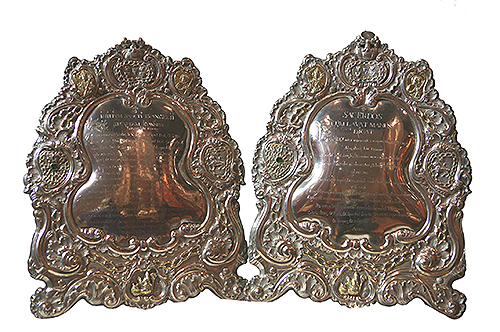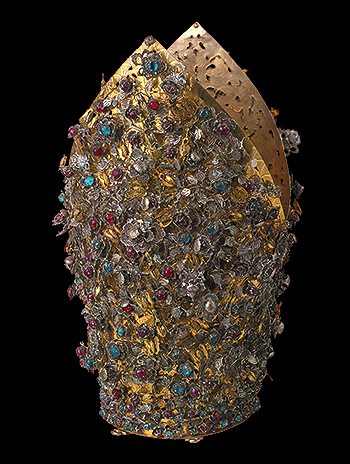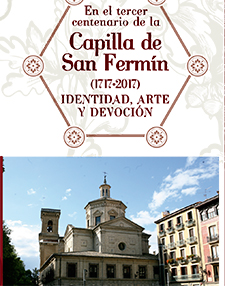On the third centenary of the
Chapel of San Fermín (1717-2017)
IDENTITY, ART AND DEVOTION
14 September 2017
The treasure of San Fermín: pieces of liturgy and devotion
D. Ignacio Miguéliz Valcarlos. Chair of Navarrese Heritage and Art
The chapel of San Fermín, which this year celebrates the third centenary of its inauguration, conserves an important collection of silverware as a result of the commissioning of pieces throughout history by its patron saint, the City Council of Pamplona, as well as the donation of works by devotees of San Fermín. It is a large collection that stands out not only for its issue, but also for the uniqueness of many of its types, and for the quality of its production. Indeed, the San Fermín treasure contains a wide range of typologies, from the most common in ecclesiastical trousseaus, such as chalices, ciboria, crosses, monstrances, navetas, censers and reliquaries, to totally extraordinary pieces that are practically unique not only in Navarre but also in Spain, such as the altar frontal and the credence, the set of mitre, infulas and crozier, or the magnificent set of jugs and fonts. Not forgetting the jewellery that the saint still treasures. Chronologically they range from the 16th century to the 20th century, the most original and sumptuous pieces being those corresponding to the Baroque centuries, when devotion to the saints experienced a strong boom and any work used both in the liturgy and in the adornment of images and chapels was likely to be made in silver.
There are three ways in which these pieces entered the chapel: firstly, direct orders from the workmen to supply the jewellery needed for the chapel's ordinary liturgy. Secondly, gifts from Pamplona City Council to give magnificence and splendour to the cult of San Fermín, as the said regiment held the board of trustees of the Chapel, despite the fact that San Fermín is not the patron saint of the city, but rather San Saturnino and the Virgen del Camino. All these pieces visibly bear the heraldic arms of the Pamplona City Council, on the one hand the coat of arms with the lion passing through, crowned by a crown and bordered with the chains of Navarre, and on the other the emblem of the five wounds, adopted by the city in 1599. And finally, the third way in which jewellery arrived corresponds to the gifts and donations made by the saint's faithful, who not only wanted to show their devotion to him, but also to demonstrate their social and economic status to their neighbours. The most extraordinary pieces in the collection are precisely the works in the latter two groups. As for the provenance of the jewellery, we have pieces from all over the world. patron saint With regard to their issue we should firstly mention those carved in the workshops of Pamplona, such as the lecterns made in 1725 or the sacred ones by Pedro Antonio de Sasa in 1764, with a rich iconography with the heraldic arms of Pamplona and Navarre, as well as the busts of the city's patron saint, San Saturnino, together with those of the kingdom, San Fermín and San Francisco Javier, as well as other more exceptional ones, such as the silver pluvial cloak that covers the bust of San Fermín, carved in 1687, the pectoral reliquary that is inscribed on his chest, the work of the craftsman Hernando de Oñate el Mayor in 1572, or the two pediments carved by Pamplona masters in 1725 and 1733. Meanwhile, due to their rarity and originality, it is worth mentioning the works from American workshops, a constant feature of Spanish silverware in the Modern Age. To this group belong a Mexican monstrance, the silver filigree works and the set of trays and jugs given to the Saint by Don José de Armendáriz y Perurena, Marquis of Castellfuerte and Viceroy of Peru in 1730. And finally, we cannot forget a totally unique set, the silver filigree mitre and crozier decorated with tembleques representing flowers and insects from the Cantonese workshop and sent by Don Felipe de Iriarte in 1764 via the Manila Galleon.
Finally, and given the quality of the pieces, mention should be made of the jewellery included in the trousseau of San Fermín, such as a gold chain with a pectoral of emeralds sent by José de Armendáriz together with the silver pieces already mentioned in 1730, a gold chain given in 1757 by Nicolás de Urtasun, and a ring with an emerald, sent from Popayán, now Ecuador, by Juan Antonio de Zelaya in 1775.



PROGRAM
Tuesday, 12th September
The baroque construction of the chapel
José Luis Molins Mugueta. Chair of Heritage and Art in Navarre
The multiplied image of Pamplona and other representations of San Fermín in Navarre
Ricardo Fernández Gracia. Chair of Heritage and Art in Navarre
Wednesday, 13 September
The academic reform of the chapel
José Luis Molins Mugueta. Chair of Navarrese Art and Heritage.
protocol and ceremonial around San Fermín
Alejandro Aranda Ruiz. Chair of Navarrese Heritage and Art
Thursday, 14th September
The treasure of San Fermín: pieces of liturgy and devotion
Ignacio Miguéliz Valcarlos. Chair of Navarrese Heritage and Art
The cult of San Fermín in the graphic collections of file Municipal of Pamplona
Ana Hueso Pérez. file Municipal of Pamplona

